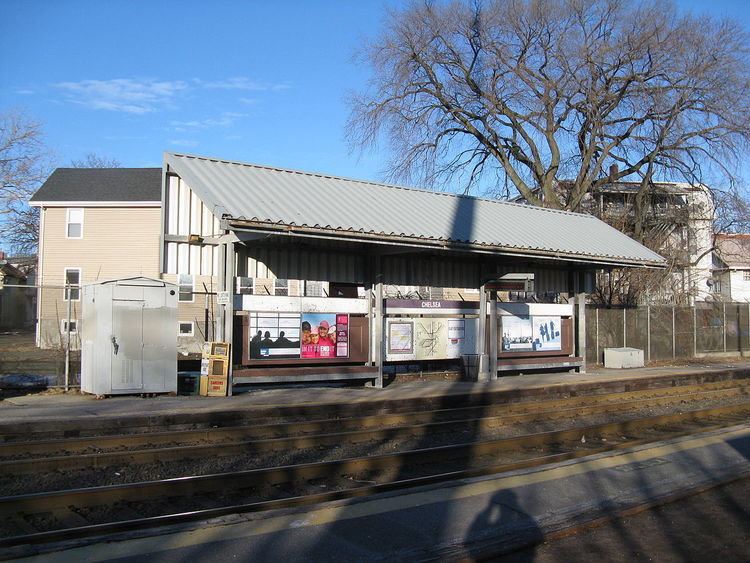Fare zone 1A Rebuilt 2017 Platforms in use 1 | Connection MBTA Bus Opened 29 November 1985 Tracks 2 | |
 | ||
Location Arlington Street & 6th Street
Chelsea, Massachusetts Line(s) Newburyport/Rockport Line Connections MBTA Bus: 111, 112, 114, 116, 117 Passengers (2013) 179 (weekday inbound average) Address Chelsea, MA 02150, United States | ||
Chelsea is a passenger rail station on the MBTA Commuter Rail Newburyport/Rockport Line, located near Bellingham Square slightly north of downtown Chelsea, Massachusetts. It is one of the more lightly-used stops on the line, with 179 daily boardings by a 2013 count; most residents commuting to downtown Boston use bus routes including the high-frequency route 111 bus instead. Unlike all other stations on the line save limited-service River Works and Prides Crossing, Chelsea is not handicapped accessible. However, the stop is planned to be moved to a new accessible station in late 2017 in conjunction with a new branch of the Silver Line bus rapid transit service.
Contents
History
After the opening of the Charlestown Bridge in 1901 and the East Boston Tunnel in 1904, Boston and Maine railroad stations in Everett and Chelsea lost ridership to slower but more frequent streetcar service. On April 18, 1958, the Boston and Maine Railroad received permission from the Public Utilities Commission to drastically curtail its suburban commuter service, including abandoning branches, closing stations, and cutting trains. Among the approved cuts was the closure of all Eastern Division service south of Lynn, including the entirety of the Saugus Branch, plus mainline stations at East Somerville, Everett, Chelsea, and Forbes. These areas were largely within the Metropolitan Transit Authority bus service area, acquired from the Eastern Massachusetts Street Railway in 1936. The Saugus Branch and mainline stations were closed on May 16, 1958.
During the late 1960s and early 1970s, the newly formed MBTA reopened several inner-suburb commuter rail stations in response to community desire for service that was faster if less frequent than buses. In 1976, Chelsea station was considered for reactivation, but ridership was expected to be relatively small due to the nearby 111 and 112 buses.
However, Chelsea station was later reopened on December 1, 1985, concurrent with the restoration of regular service on the Rockport/Ipswich Line following the 1984 fire that destroyed the Beverly Draw. The station was built onto the existing right of way, with one platform taking up the former track utilized by the Boston & Albany Railroad's Grand Junction Branch, rather than going through the potentially costly and controversial eminent domain process to acquire land for a larger station. The rails of the former track were still visible in the platform until it was removed in 2015. Due to the location and short length of the platforms, trains are forced to block the Sixth Street crossing while loading and unloading passengers.
Future plans
Chelsea Station was a proposed stop on the MBTA's Urban Ring Project. The Urban Ring was to be a Bus Rapid Transit (BRT) line designed to connect the current MBTA Lines to reduce strain on the downtown stations. The full project is shelved due to the MBTA's financial difficulties, but some corridor routes are receiving more limited work.
In March 2013, the MBTA began studying an extension of the Silver Line to Chelsea via a newly constructed bypass road in East Boston. Three alternatives were discussed for the Chelsea section. One would run up the abandoned section of the Grand Junction Railroad right-of-way from Eastern Avenue to Chelsea station with stops at Eastern Avenue, Highland/Box District, Chelsea station, and Mystic Mall. The second alignment would follow the Grand Junction to just short of the station, then diverge onto surface roads to Bellingham Square. The third alignment would run entirely on surface streets, serving two stops on Central Avenue and four stops along a loop serving Chelsea station and the MGH Chelsea healthcare center.
In September 2013, the MBTA indicated that it would pursue the first alternative despite potential issues with bridge clearances and rebuilding Chelsea station.
On October 30, 2013, MassDOT announced $82.5 million in state funding for a modified version of the first alternative to be constructed. A new $20 million Chelsea commuter rail station and 'transit hub' will be constructed at the Mystic Mall terminus of the new Silver Line route, so that trains will no longer block Sixth Street. The Silver Line will have a new "Downtown Chelsea" stop, at the current station location. The new transfer station will be fully handicapped accessible.
In June 2015, the outbound platform was removed to make way for the busway construction. A temporary asphalt platform was placed between the tracks.
As of October 2016, bidding for the $28.4 million project is expected to open in March 2017.
Bus connections
Five MBTA Bus routes converge on Bellingham Square near the station:
The 112 and 114 serve the station directly on 6th Street, while the 111, 116, and 117 run on other streets to the east. The 111, 116, and 117 are key bus routes with high-frequency service at all operating hours, including extended service on Friday and Saturday nights.
The future Mystic Mall station location will be served by the 112 and 114 routes as well as the yet-unnumbered Silver Line branch.
